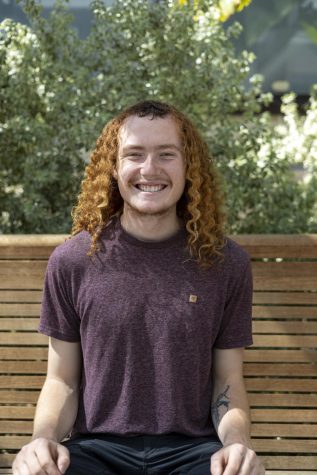As COVID-19 pandemic enters third year, Corvallis community looks toward future
A sign urging patrons to stay six feet apart at Long Timber Brewing in Monroe, Ore. on Jan. 14. COVID-19 restrictions continue to require individuals to keep six feet of distance between themselves and others, which can be difficult for smaller businesses to accommodate.
February 7, 2022
The COVID-19 pandemic is now entering its third year, and the Corvallis, Ore. community has seen effects on all aspects of life, leading residents to wonder about the path forward.
“The SARS-CoV-2 virus is unlikely to go away anytime soon without significant increases in population-level immunity across the world,” said April Holland, public health administrator for the Benton County Public Health Department. “We are still squarely in a pandemic, with huge numbers of people seriously affected by COVID-19.”
Since the beginning of the pandemic, Benton County has seen 13,388 cases total. Due to the omicron variant, daily case counts have been climbing again with 284 new cases on Jan. 31. On Feb. 4, there were 103 new cases of COVID-19 reported in the county.
“I would argue that we cannot adapt well to the virus while it is causing widespread disruption to the health and daily lives of our community members,” Holland said. “However, we have made great progress since the first U.S. case was identified on Jan. 21, 2020.”
According to Holland, Benton County and the world have made major strides in COVID-19 vaccination rates and treatment. However, moving forward there are still big steps to be taken—according to Holland, vaccination can save lives, as can increased testing, masking indoors, encouraging physical distancing, staying home when sick, avoiding crowds and practicing general hygiene. In Oregon, 68% of the population is fully vaccinated.
While some experts now agree that there may not be a magic number for herd immunity against COVID-19, according to “Herd Immunity: Will We Ever Get There?” from Yale Medicine, especially with new variants that are more contagious, some experts say that 85% of the population should be vaccinated.
“I am proud to say that this county is one of the most vaccinated counties in Oregon,” said Jennifer Moreland, executive director of the Downtown Corvallis Association. “I believe that our county, or Corvallis, will come out better than others…We will feel the effects, but maybe not as much as other communities.”
Even with high vaccination rates in Benton County, Holland said the community is still dependent on other counties and the rest of the world.
Local businesses have been particularly affected by the constant changes of the pandemic.
“Corvallis has been hit pretty hard,” said Simon Date, the president and chief executive officer of the Corvallis Chamber of Commerce. “The nature of our business community make-up—the fact that it’s smaller business than perhaps you would find in a typical community—leads to stronger effects, businesses strapped in form of income… It was rough; we have a lot of restaurants here that are mom and pop restaurants, folks doing their best to provide the community with amazing food, and those are the ones that are hit hard.”
According to Date, it is extremely difficult to put a number on the businesses that have closed down through the pandemic, but estimates the figure hovers around 10%. However, Date said this percentage is likely low, because there are a lot of unregistered home businesses in the area which have no official record of closing, since Corvallis and Benton County have no company registration policies.
Looking forward, Date said people should likely expect more of the same in the third year of the COVID-19 pandemic. However, people should not expect to see any of the hard shutdowns that were first seen in April of 2020. Businesses will likely continue to stay open, which means less of the rollercoaster changes of the last few years, and the community is entering a place where things have been normalized, Date said.
“With the current variants continuing to drive the latest surge, getting vaccinated [and a] booster now can provide the best protection available today and more quickly slow the spread of the virus,” Holland said. “We don’t know yet when we’ll be able to stop wearing masks and maintaining physical distance, or reach a level of community immunity, but as more people are vaccinated and boosted, we move closer to having life return to normal.”


















































































![Newspaper clipping from February 25, 1970 in the Daily Barometer showing an article written by Bob Allen, past Barometer Editor. This article was written to spotlight both the student body’s lack of participation with student government at the time in conjunction with their class representatives response. [It’s important to note ASOSU was not structured identically to today’s standards, likely having a president on behalf of each class work together as one entity as opposed to one president representing all classes.]](https://dailybaro.orangemedianetwork.com/wp-content/uploads/2025/03/Screenshot-2025-03-12-1.00.42-PM-e1741811160853.png)

























